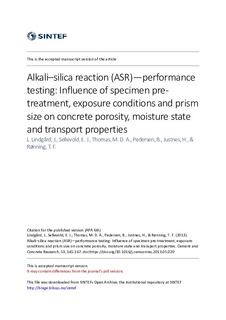| dc.contributor.author | Lindgård, Jan | |
| dc.contributor.author | Sellevold, Erik Johan | |
| dc.contributor.author | Thomas, Michael D.A. | |
| dc.contributor.author | Pedersen, Bård | |
| dc.contributor.author | Justnes, Harald | |
| dc.contributor.author | Rønning, Terje F. | |
| dc.date.accessioned | 2018-06-22T06:52:45Z | |
| dc.date.available | 2018-06-22T06:52:45Z | |
| dc.date.created | 2013-07-15T10:58:45Z | |
| dc.date.issued | 2013 | |
| dc.identifier.citation | Cement and Concrete Research. 2013, 53 (November), 145-167. | nb_NO |
| dc.identifier.issn | 0008-8846 | |
| dc.identifier.uri | http://hdl.handle.net/11250/2502606 | |
| dc.description.abstract | Abstract
Whether or not concrete prism tests (CPTs) developed for assessment of alkali-silica reactivity of aggregates might be suitable for general ASR performance testing of concrete has been evaluated. This paper presents the background for the choice of test procedures and results on how variations in specimen pre-treatment, ASR exposure conditions and prism size influence concrete porosity, moisture state and transport properties. Results from measurements of alkali leaching and prism expansions during the ASR exposure are presented in a separate paper, together with discussion of consequences for ASR test procedures.
For ordinary Portland cements and with water-to-cementitious-materials ratio (w/cm) 0.45 and higher it was found that the internal moisture state is sufficiently high in all the assessed procedures to produce ASR expansion. However, for less permeable concretes lack of internal moisture and lower rate of diffusion can significantly reduce the rate and extent of ASR expansion during laboratory performance testing. | nb_NO |
| dc.description.sponsorship | ACNOWLEDGEMENT. The authors would also like to acknowledge COIN, the COncrete INnovation centre (www.coinweb.no) and Norcem (part of Heidelberg Cement Group) for the financial support to the PhD study of the principle author. Furthermore, the comprehensive and accurate work performed at the laboratory staff at SINTEF is greatly appreciated. | nb_NO |
| dc.language.iso | eng | nb_NO |
| dc.publisher | Elsevier | nb_NO |
| dc.rights | Attribution-NonCommercial-NoDerivatives 4.0 Internasjonal | * |
| dc.rights.uri | http://creativecommons.org/licenses/by-nc-nd/4.0/deed.no | * |
| dc.subject | Alkali–Aggregate reaction (C) | nb_NO |
| dc.subject | Performance testing | nb_NO |
| dc.subject | Moisture | nb_NO |
| dc.subject | Porosity | nb_NO |
| dc.subject | Permeability | nb_NO |
| dc.title | Alkali–silica reaction (ASR)—performance testing: Influence of specimen pre-treatment, exposure conditions and prism size on concrete porosity, moisture state and transport properties | nb_NO |
| dc.type | Journal article | nb_NO |
| dc.type | Peer reviewed | nb_NO |
| dc.description.version | acceptedVersion | nb_NO |
| dc.rights.holder | © 2013 Elsevier B.V. All rights reserved. This is the authors' accepted and refereed manuscript to the article, post-print. Released with a Creative Commons Attribution Non-Commercial No Derivatives License. The final publication is available at https://doi.org/10.1016/j.cemconres.2013.05.020 | nb_NO |
| dc.subject.nsi | VDP::Teknologi: 500 | nb_NO |
| dc.source.pagenumber | 145-167 | nb_NO |
| dc.source.volume | 53 | nb_NO |
| dc.source.journal | Cement and Concrete Research | nb_NO |
| dc.source.issue | November | nb_NO |
| dc.identifier.doi | 10.1016/j.cemconres.2013.05.020 | |
| dc.identifier.cristin | 1039046 | |
| dc.relation.project | Norges forskningsråd: 174878 | nb_NO |
| cristin.unitcode | 7401,30,40,0 | |
| cristin.unitname | Arkitektur, byggematerialer og konstruksjoner | |
| cristin.ispublished | true | |
| cristin.fulltext | postprint | |
| cristin.qualitycode | 2 | |

